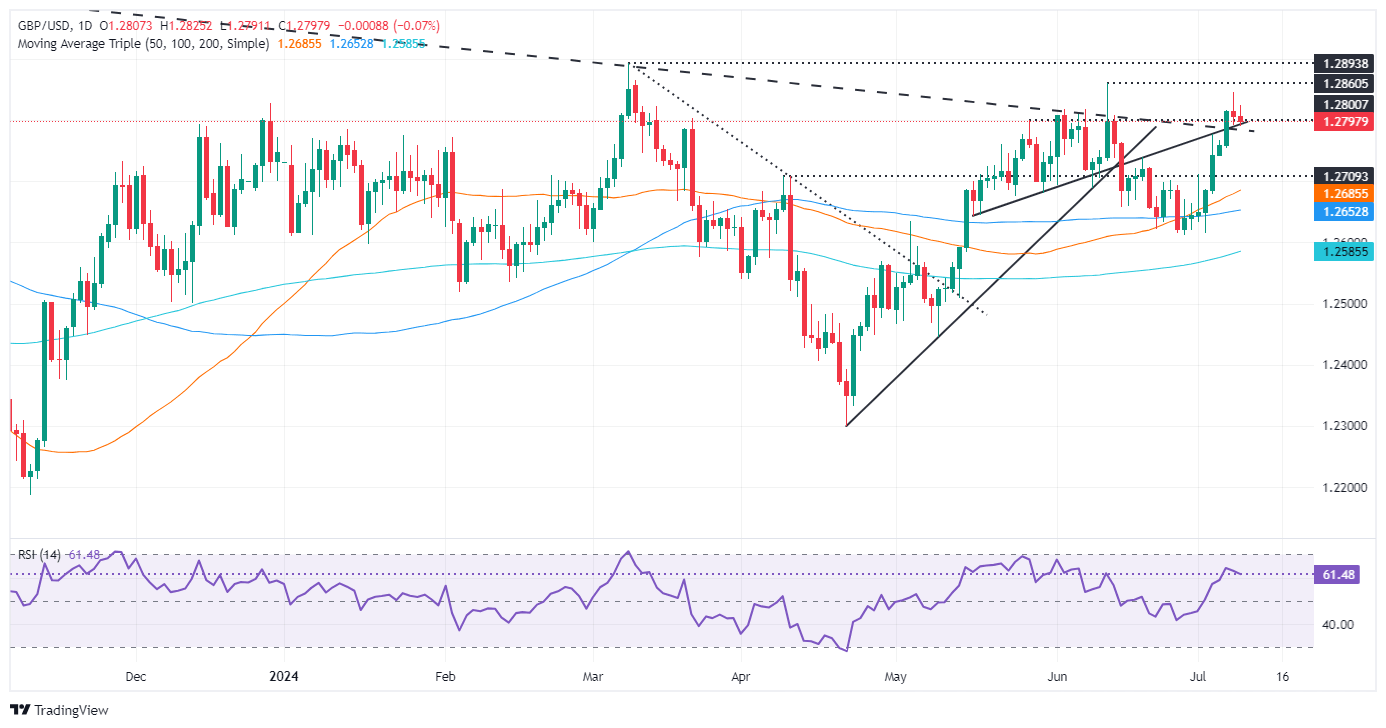GBP/USD Price Analysis: Slips below 1.2800 as ‘evening star’ formation looms
- GBP/USD trades losses of more than 0.10% during Powell's Senate appearance.
- ‘Shooting star’ pattern hints at further downside if July 8 low of 1.2785 is breached.
- Key support levels at 1.2750/75 and 1.2709, while resistance lies at 1.2845 and 1.2860.

The GBP/USD falls during the North American session as Federal Reserve Chairman Jerome Powell appears at the US Senate Banking Committee. At the time of writing, the pair trades with minimal losses of 0.10%, just below the 1.2800 figure.
GBP/USD Price Analysis: Technical outlook
The GBP/USD uptrend remains intact, but the formation of a ‘shooting star’ on Monday’s price action hints that the pair could aim lower if spot prices tumble below the July 8 low of 1.2785.
Momentum, as measured by the Relative Strength Index (RSI), favors buyers, but they are losing steam as the RSI’s slope aims slightly downward.
Short-term, if GBP/USD achieves a daily close beneath the July 8 low, an ‘evening star’ three-candle bearish chart pattern would emerge, opening the door for further losses. In that outcome, the pair’s first support would be the confluence of two support trends at around 1.2750/75. Once cleared, the Pound Sterling could drop towards April’s 9 high at 1.2709 before challenging 1.2700.
Conversely, if buyers defend 1.2800, it could pave the way for resuming the uptrend. The first ceiling level would be the July 8 high at 1.2845, followed by the June 12 peak at 1.2860. Once those two levels are cleared, buyers can challenge the year-to-date (YTD) high just beneath the 1.2900 figure.
GBP/USD Price Action – Daily Chart
Pound Sterling FAQs
The Pound Sterling (GBP) is the oldest currency in the world (886 AD) and the official currency of the United Kingdom. It is the fourth most traded unit for foreign exchange (FX) in the world, accounting for 12% of all transactions, averaging $630 billion a day, according to 2022 data. Its key trading pairs are GBP/USD, aka ‘Cable’, which accounts for 11% of FX, GBP/JPY, or the ‘Dragon’ as it is known by traders (3%), and EUR/GBP (2%). The Pound Sterling is issued by the Bank of England (BoE).
The single most important factor influencing the value of the Pound Sterling is monetary policy decided by the Bank of England. The BoE bases its decisions on whether it has achieved its primary goal of “price stability” – a steady inflation rate of around 2%. Its primary tool for achieving this is the adjustment of interest rates. When inflation is too high, the BoE will try to rein it in by raising interest rates, making it more expensive for people and businesses to access credit. This is generally positive for GBP, as higher interest rates make the UK a more attractive place for global investors to park their money. When inflation falls too low it is a sign economic growth is slowing. In this scenario, the BoE will consider lowering interest rates to cheapen credit so businesses will borrow more to invest in growth-generating projects.
Data releases gauge the health of the economy and can impact the value of the Pound Sterling. Indicators such as GDP, Manufacturing and Services PMIs, and employment can all influence the direction of the GBP. A strong economy is good for Sterling. Not only does it attract more foreign investment but it may encourage the BoE to put up interest rates, which will directly strengthen GBP. Otherwise, if economic data is weak, the Pound Sterling is likely to fall.
Another significant data release for the Pound Sterling is the Trade Balance. This indicator measures the difference between what a country earns from its exports and what it spends on imports over a given period. If a country produces highly sought-after exports, its currency will benefit purely from the extra demand created from foreign buyers seeking to purchase these goods. Therefore, a positive net Trade Balance strengthens a currency and vice versa for a negative balance.
British Pound PRICE Today
The table below shows the percentage change of British Pound (GBP) against listed major currencies today. British Pound was the strongest against the Japanese Yen.
| USD | EUR | GBP | JPY | CAD | AUD | NZD | CHF | |
|---|---|---|---|---|---|---|---|---|
| USD | 0.08% | 0.09% | 0.32% | 0.03% | 0.05% | 0.04% | -0.01% | |
| EUR | -0.08% | -0.02% | 0.24% | -0.04% | -0.03% | -0.04% | -0.08% | |
| GBP | -0.09% | 0.02% | 0.25% | -0.06% | -0.00% | -0.02% | -0.07% | |
| JPY | -0.32% | -0.24% | -0.25% | -0.31% | -0.28% | -0.29% | -0.33% | |
| CAD | -0.03% | 0.04% | 0.06% | 0.31% | 0.02% | 0.04% | -0.03% | |
| AUD | -0.05% | 0.03% | 0.00% | 0.28% | -0.02% | -0.02% | -0.07% | |
| NZD | -0.04% | 0.04% | 0.02% | 0.29% | -0.04% | 0.02% | -0.04% | |
| CHF | 0.00% | 0.08% | 0.07% | 0.33% | 0.03% | 0.07% | 0.04% |
The heat map shows percentage changes of major currencies against each other. The base currency is picked from the left column, while the quote currency is picked from the top row. For example, if you pick the British Pound from the left column and move along the horizontal line to the US Dollar, the percentage change displayed in the box will represent GBP (base)/USD (quote).
Author

Christian Borjon Valencia
FXStreet
Christian Borjon began his career as a retail trader in 2010, mainly focused on technical analysis and strategies around it. He started as a swing trader, as he used to work in another industry unrelated to the financial markets.


















